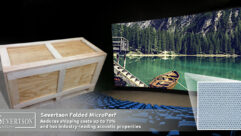

“A Midsummer Night’s Dream” opened in The Samuel H. Scripps Mainstage, a 299-seat uniquely flexible space inspired by the Cottesloe Theatre on London’s Royal National Theatre. The Scripps merges an Elizabethan courtyard theatre with a modern black box. It has seven configurations and is 35 foot high from floor to grid, nearly twice the height of a typical Off Broadway theatre.
Taymor and her set designer, Es Devlin, devised a deep thrust configuration that reduced seating to 284. The deep thrust enabled the audience to get close to the stage and the performers and immerse themselves in The Bard’s magical comedy. During the show, expansive moving pieces of fabric serve as multi-functional projection surfaces: They act as the sky, a wedding canopy and bower; performers on flying rigs slide down the fabric and are raised and lowered on it. Fabric sometimes becomes a ground cloth that later disappears down a trap. Fabric tumbles out of the back wall. All of it is mapped with projections to set the scene for weddings, woods and fairies galore.
“It’s not an overstatement to say that the support of WorldStage was one of the essential elements that made this production possible,” says Jeffrey Horowitz, founding artistic director of TFANA. “This show is on a completely different scale for TFNA than any other of our productions in our 34 year history. The audience wrapped around the thrust on three levels. I’ve worked with projections before but never at this level of complexity. It was an incredible feat for WorldStage to configure the projectors and focus them to map the images precisely to the huge canopies of fabric. The staging appears to have the lightness and playfulness of a dream.”
Sven Ortel designed projections that feature a lot of naturalistic and woodsy elements, layered clouds with evocative colors and a number of fairy elements, including slow-motion footage of moths in various sizes and intensities, which represents the fairy kingdom. Animated cut-out silhouettes also create “a bit of mystery in a scary, fairy-tale way,” he adds.
WorldStage’s Lars Pedersen notes that, “the rectangular shape of the black-box theatre itself, the shapes of the projection surfaces and the fact that the fabric moves – it raises, it lowers, it billows, it vanishes down the trap at times – posed significant challenges for us. The projector configuration was unusual to the extreme with many of the projectors having to be placed in close proximity to the audience seating. Beyond the nonconforming projection angles, we also had to account for noise abatement when considering projector placement.”
Different types of fabric were tested to make sure the imagery would read well on the material and the fabric would “recede into nothing when it’s not acting as a projection surface,” Ortel explains. “We found a sheer, quite translucent fabric that looks quite magical.”
Ortel calls “A Midsummer Night’s Dream” “one of the most challenging projects I’ve ever done from an installation point of view. I contacted Lars and (WorldStage president) Josh (Weisberg) very early on. They came on board with all they had to help us pull it off. They gave us a lot of confidence no matter what bold, challenging ideas Julie (Taymor) or I came up with.”
Ortel selected seven Christie projectors, which are mounted in the grid, low to the floor and on the back tiers of the theatre. Two Christie Roadster S+20K projectors provide top floor projection; an M Series DS+10KM near front projection; an M Series HD-14K-M video projector far front projection; one M Series DS+10KM back projection (flown) and four more M Series units to handle canopy projection.
“The projectors had to be positioned where they wouldn’t be in the way of the performers and still fulfill the function of covering certain surfaces,” notes Ortel. “Lars and his team helped me make it work – they wouldn’t go home until the job was done and that took quite some time with various iterations and changes.” Since the theatre had to act as a rehearsal venue during the day, time on site for WorldStage was limited to evenings and late nights.
The Christie projectors were chosen primarily for their low-noise, small footprint, and 110v operation. “In addition, the ChristieNET control software allowed the operators to quickly and effortlessly monitor and modify projector status throughout the run of the show.”
“We opted to go with the d3 server platform on this job due its inherent ability to facilitate image mapping along with a myriad of other incredibly useful features. We immediately recognized the difficulties we were up against given the amorphous form of the projection surfaces. Not only were we concerned about the indeterminate shapes of the fabric, but we also had to account for the fact that the fabric would reside in various stage positions. In order to create the requisite d3 mesh objects we employed a very sophisticated laser instrument to measure and record the vital information of the various shapes and positions of the fabric within the 3D space of the venue. We then used a brand new feature in d3 called Mesh Animation. This feature allowed us to seamlessly transition imagery and mapping information from one fabric shape and position to another in real time.”
Jeffrey Horowitz notes that TFANA’s production of “A Midsummer Night’s Dream” has received “spectacular reviews and audiences are having a wonderful time. The imagery and production are fresh – Shakespeare wrote images, and this all comes from what he wrote. But it’s not duplicative of Shakespeare, it’s additive. You can sense its aliveness.”
“The show has been a big success for everyone involved,” says Ortel. “It’s been everything that we’ve hoped for – it’s really unlike anything anyone has seen before. What has been particularly exciting for me is to get email and Tweets from young projection designers who have been inspired by what they’ve seen. That’s a compliment to all of us, including WorldStage.”
“It’s unbelievable what WorldStage did for us,” Horowitz concludes. “A theatre only opens once. This production was the fireworks we hoped it would be, and WorldStage was a big part of the gunpowder!”
WorldStage Inc., the company created by the merger of Scharff Weisberg Inc and Video Applications Inc, continues a thirty-year legacy of providing clients the widest variety of entertainment technology coupled with conscientious and imaginative engineering services. WorldStage provides audio, video and lighting equipment and services to the event, theatrical, broadcast and brand experience markets nationally and internationally.










